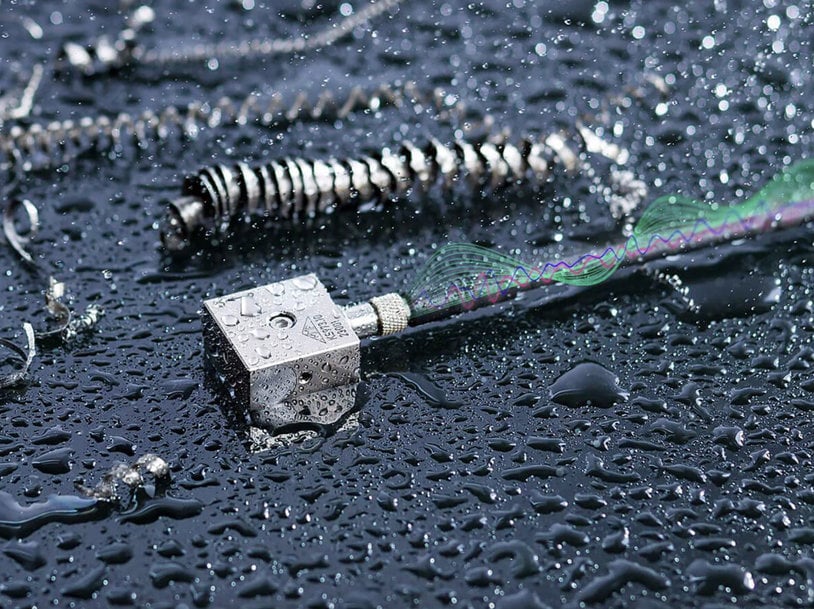railway-international.com
11
'24
Written on Modified on
ASC rounds off portfolio with lightweight piezoelectric sensors
With the recent addition of piezoelectric sensor technology to its product portfolio, ASC Sensors is now able to offer an even broader range of inertial sensor solutions.
www.asc-sensors.de

Through a brand-new collaboration with Metra Mess- und Frequenztechnik (MMF) signed in October 2024, the German sensor specialist will be able to offer MMF’s tried and tested IEPE (Integrated Electronics Piezo-Electric) technology in tailormade solutions for customers in Austria, Germany and Switzerland.
Why piezoelectric sensors?
MMF has been manufacturing accelerometers utilizing the phenomenon of the piezoelectric effect for over 60 years. “Piezo” is from Greek, meaning to squeeze. When input acceleration causes the piezoelectric material to stress, it produces an electrical charge proportional to the acceleration. The IEPE circuitry converts this charge to an analog voltage output signal.
The active element of MMF’s accelerometers consists of a distinct ceramic material. The excellent piezoelectric properties provide stable performance and long-term stability. High stability is achieved by means of an artificial aging process of the piezoceramic sensing element. The sensitivity of ceramics can be about 100 times higher than that of quartz materials.
While every inertial sensor technology has its unique benefits, those of MMF’s piezoelectric accelerometers include:
- Extremely high dynamic range and excellent linearity – suitable for shock measurement as well as for almost imperceptible vibration
- Wide frequency range enables the measurement of very high frequencies up to 19 kHz (±5 %)
- Almost free of noise (<400 to 3000 µg) over their wide bandwidth
- High operating temperatures of up to +120 °C
- Selection of two different sensitivity versions, 10 mV/g or 100 mV/g
- Flat, cylindric or cubic design and always low mass down to 2.4 grams
Light sensors for lightweight applications
To date, ASC has been offering a great range of its own innovative capacitive sensors, industrial grade IEPE accelerometers, gyroscopes, inertial measurement units as well as quartz-based sensors through a partnership with Japan Aviation Electronics Industry, Ltd (JAE). “Our goal has always been to offer a broad portfolio of inertial sensors covering all possible scenarios and eventualities,” explains Renate Bay, General Manager of ASC. “With this latest addition to our ‘sensor family’, we’re able to do just that. Customers will get the most suitable solution across these technologies, or a combination if that’s the best approach given their specific requirements.”
Key features of IEPE sensors include their small, lightweight build and extremely high frequency range of far beyond 10 kHz. “No capacitive sensor is able to match that,” clarifies Bay. “And we’re talking extremely light sensors of a few grams only. Which can be critical wherever sensor weight could impact measurement results.” Therefore, these compact IEPE accelerometers are predominantly used in demanding test and measurement applications such as structural and modal analyses for automotive and railway testing, lightweight planes and other light constructions.
To date, ASC has been offering a great range of its own innovative capacitive sensors, industrial grade IEPE accelerometers, gyroscopes, inertial measurement units as well as quartz-based sensors through a partnership with Japan Aviation Electronics Industry, Ltd (JAE). “Our goal has always been to offer a broad portfolio of inertial sensors covering all possible scenarios and eventualities,” explains Renate Bay, General Manager of ASC. “With this latest addition to our ‘sensor family’, we’re able to do just that. Customers will get the most suitable solution across these technologies, or a combination if that’s the best approach given their specific requirements.”
Key features of IEPE sensors include their small, lightweight build and extremely high frequency range of far beyond 10 kHz. “No capacitive sensor is able to match that,” clarifies Bay. “And we’re talking extremely light sensors of a few grams only. Which can be critical wherever sensor weight could impact measurement results.” Therefore, these compact IEPE accelerometers are predominantly used in demanding test and measurement applications such as structural and modal analyses for automotive and railway testing, lightweight planes and other light constructions.

